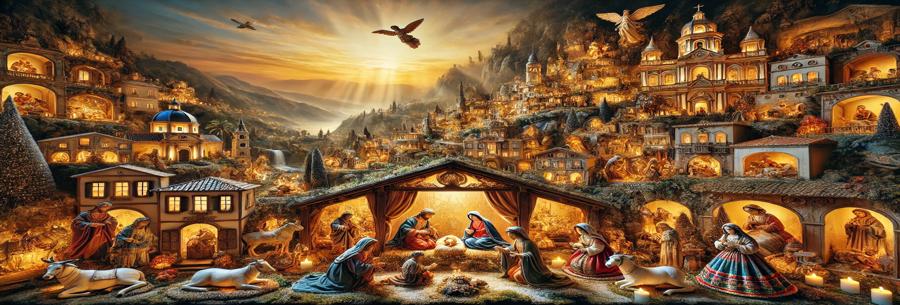The Christmas cot is a tradition that crosses borders and cultures, embodying the profound symbolism of the Nativity while reflecting the identity and artistic riches of each region. From modest wooden cots to monumental compositions adorned with exquisite detail, these representations of the birth of Jesus are much more than decorations: they are works of art and acts of faith. This article takes you on a world tour of the most beautiful nativity scenes, where art and spirituality meet.
The origins of the crib
The history of the cot begins in the 13th century with St Francis of Assisi, who is said to have set up the first living cot in Italy to make the Nativity more accessible to the faithful. Soon, this tradition spread, and miniature cots began to adorn churches, homes and public squares.
Emblematic cots around the world
The Neapolitan cot (Italy): this is probably the most famous in the world. A true artistic gem, it blends characters from the Nativity with scenes from everyday life.
Features: terracotta or painted wooden figurines, often dressed in precious fabrics.
Symbolism:Each figure represents a trade or social class, underlining the idea that the Nativity concerns all strata of society.
Iconic place:The San Martino Museum in Naples houses an impressive collection of Neapolitan nativity scenes, some dating back to the 18th century.
The Provençal nativity scene (France): In Provence, the nativity scene is a veritable institution, enriched by the famous santons (small clay figurines).
Features: as well as the Holy Family, there are regional figures such as the baker, the shepherd and the washerwoman.
Tradition: every year, Christmas markets in Provence offer hundreds of santons to complete family nativity scenes.
Iconic place: the church of Les Saintes-Maries-de-la-Mer exhibits a large Provençal nativity scene during the festive season.
The Polish nativity scene: or szopka, is a fascinating blend of Christian traditions and folk art.
Features:Colourful structures made of paper or wood, often inspired by Gothic architecture.
Particularity : Nativity scenes are sometimes mobile, animated by mechanisms that move the characters.
Iconic place : Every year, a szopki competition is held in Krakow, rewarding the most beautiful creations.
The Andean nativity scene (South America): In the Andes, nativity scenes reflect local traditions by incorporating elements of indigenous culture.
Features: Jesus, Mary and Joseph are often dressed as Andean inhabitants, with ponchos and traditional hats.
Symbolism: Llamas often replace sheep, and the decorations include mountains and landscapes typical of the region.
Iconic place: Peruvian ceramic nativity scenes, originating in Ayacucho, are particularly prized.
The Philippine nativity scene: it's a spectacular, collective celebration, incorporating local materials and bright lights.
Features:Giant nativity scenes, known as belen, are often made from bamboo, mother-of-pearl or rice paper.
Tradition:During the festive season, illuminated nativity scene competitions are held throughout the country.
Iconic place:The San Fernando Christmas Festival is famous for its monumental illuminated nativity scenes.
Spirituality at the heart of nativity scenes
Beyond their beauty, nativity scenes are a reminder of the humility of Christ's birth. Each culture, by adding its distinctive elements, expresses a shared faith and a universal message: that of peace, love and hope.
Modern and contemporary nativity scenes
Many contemporary artists are revisiting the nativity scene with innovative materials and forms:
In glass or metal: Minimalist nativity scenes that play on light and transparency.
Ecological: Made from recycled or natural materials, they emphasise the importance of preserving Creation.
Interactive: Some nativity scenes include projections or animations to tell the story of the Nativity.
Nativity scenes from around the world bear witness to the richness of faith and human creativity. Whether traditional or modern, they are a reminder that Christmas is above all a spiritual celebration, a time for gathering and reflection. Diving into the history and art of these nativity scenes also means rediscovering the universality of the message of the Nativity.




















